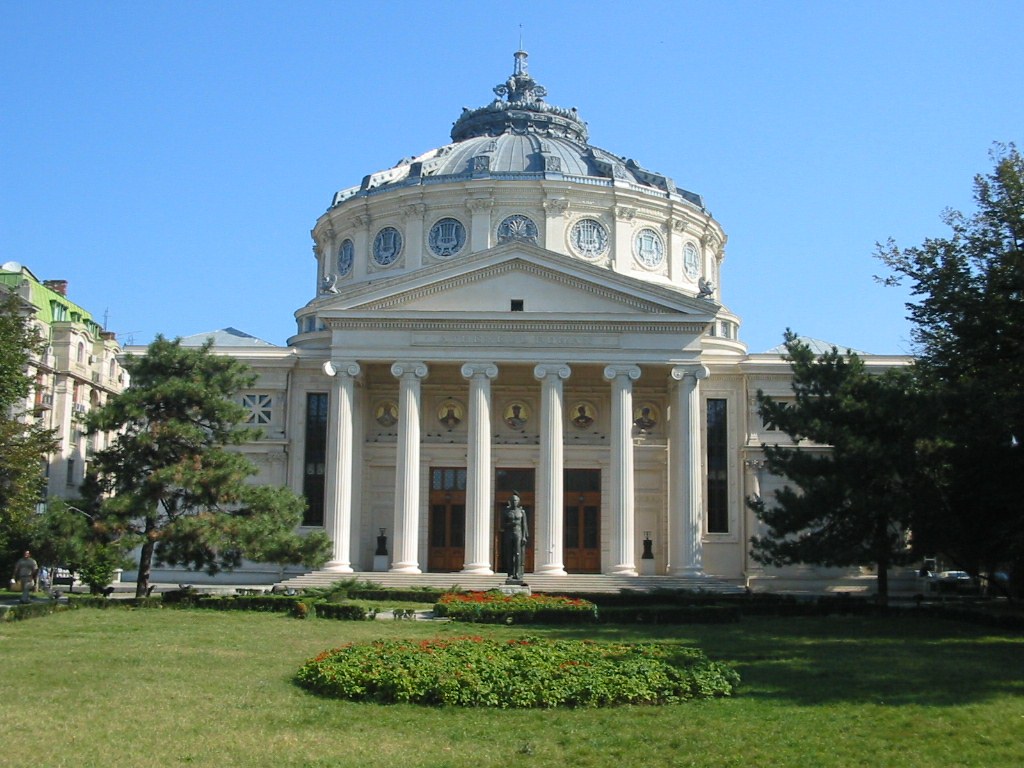- Romanian Athenaeum
Infobox Theatre
name = Romanian Athenaeum
address = str. Franklin nr. 1-3, sector 1
city =Bucharest
country =Romania
latitude = 44.4414
longitude = 26.0971
architect =Albert Galleron
owner = Romanian Philharmonic Society
capacity = 794
opened = 1888
rebuilt = 1992, Raluca Nicoara
website = fge.org.ro The Romanian Athenaeum (Romanian: "Ateneul Român") is aconcert hall in the center ofBucharest ,Romania and a landmark of the Romanian capital city. Opened in 1888, the ornate, domed, circular building is the city's main concert hall and home of the "George Enescu" Philharmonic and of theGeorge Enescu annual international music festival.History
In 1865, cultural and scientific personalities such as Constantin Esarcu, V. A. Ureche, and
Nicolae Creţulescu founded the Romanian Atheneum Cultural Society. To serve its purposes, the Romanian Athenaeum, a building dedicated to art and science, would be erected in Bucharest. [ [http://fge.org.ro/ateneul-roman/ The Romanian Athenaeum] on the official site of the George Enescu Philarmonic]The building was designed by the French architect
Albert Galleron , built on a property that had belonged to theVăcărescu family and inaugurated in 1888, although work continued until 1897. A portion of the construction funds was raised by public subscription in a 28-year long effort, of which the slogan is still remembered today: "Spend one "leu" for the "Ateneu"!" [ [http://www.nouaromanie.ro/redescoperirea%20romaniei_files/ateneul%20roman.htm Page about the Romanian Athenaeum] provides a detailed description of the scenes from Romanian history portrayed in the frescoes of the Atheneum. ro icon]On
December 29 ,1919 , the Atheneum was the site of the conference of leading Romanians who voted to ratify the unification ofBessarabia ,Transylvania , andBukovina with theRomanian Old Kingdom to constituteGreater Romania .Extensive reconstruction and restoration work has been conducted in 1992 by a Romanian construction company and restoration painter Silviu Petrescu, saving the building from collapse. The 9 million Euro required were contributed in equal shares by the government and the Council of Europe Development Bank. [ [http://www.constructiv.ro/arhiva/2003/06_iunie/curent_cuprins1.html 1992 reconstruction work] includes an excellent image of the inside of the dome during construction. ro icon]
Building and facilities
The overall style is neoclassical, with some more romantic touches. In front of the building there is a small park and a statue of Romanian poet
Mihai Eminescu .Inside, the ground floor hosts an ornate conference hall as large as the
auditorium above; the auditorium seats 600 in the stalls and another 52 in loge seating.A 75-sqm long and 3-m wide
fresco decorates the inside of the circular wall of the concert hall. Painted using the "al fresco" technique, the piece depicts the most important moments of Romanian history, starting with the conquest ofDacia by Roman emperorTrajan and ending with the realization ofGreater Romania in 1918.Recognized as a symbol of Romanian culture, the building has been inscribed in 2007 on the list of the Label of European Heritage sights. [ [http://nato.mae.ro/index.php?lang=en&id=31&s=23698&arhiva=true Romanian Athenaeum awarded Label of European Heritage] , Romania's Permanent Delegation to NATO]
References
See also
*
List of major concert halls
*George Enescu Festival Gallery
Wikimedia Foundation. 2010.
